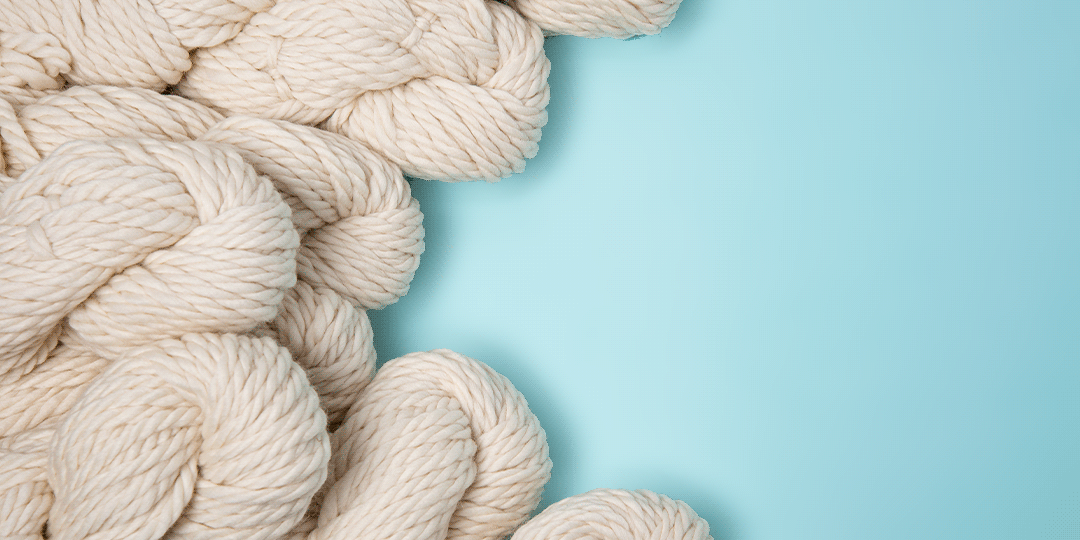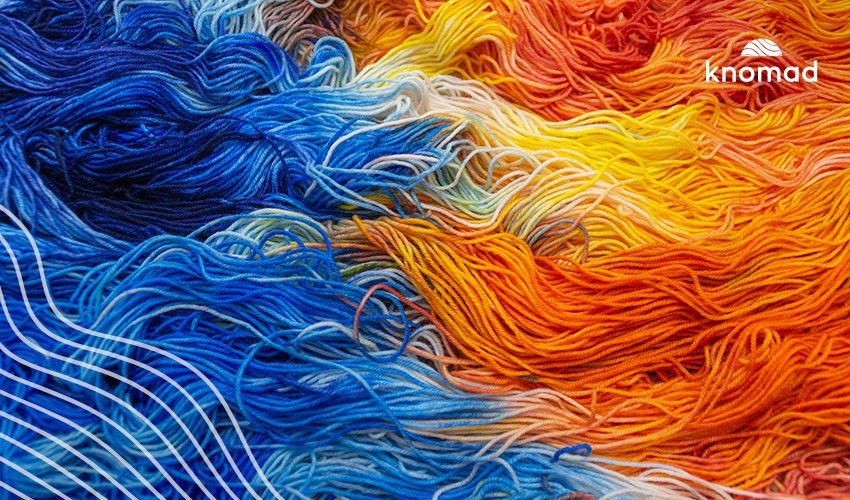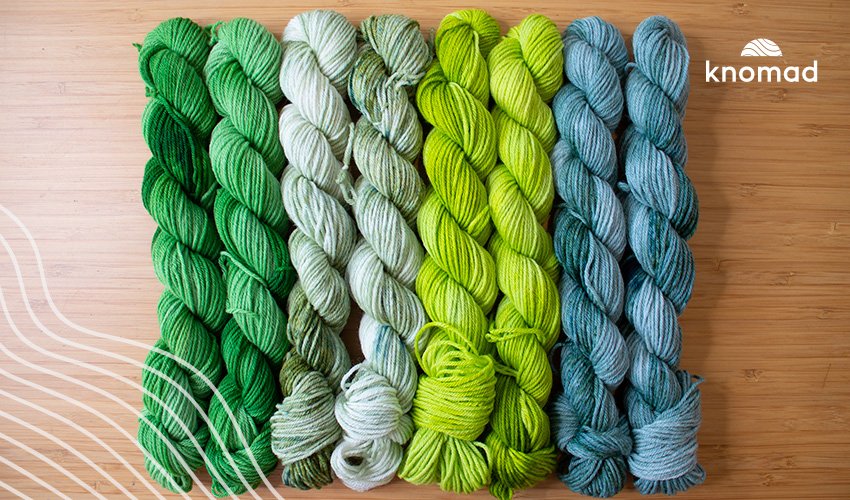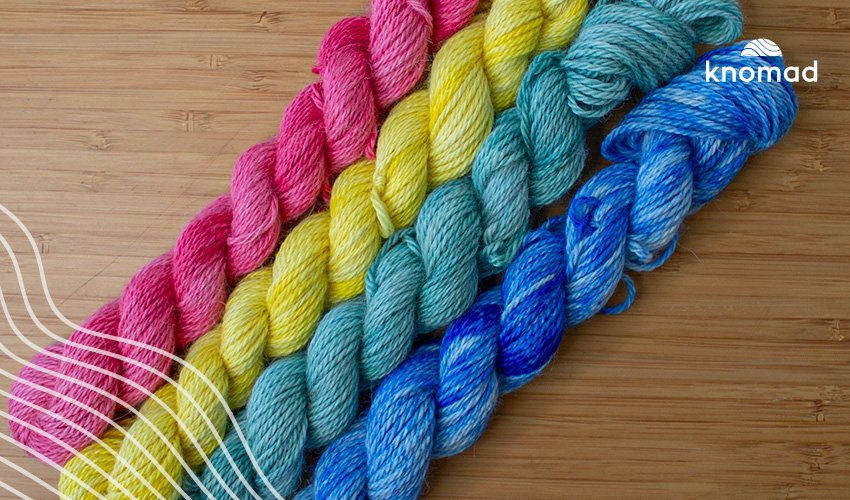Natural Dyes for Wool: Sequoia
Today, I’m going to share one of my absolute favorite natural dyes with you: Sequoia, and we’re going to apply it to some really luxurious, 100% Baby Alpaca undyed yarn from Knomad, for the ultimate in knitting, crocheting or weaving luxury.
If you live in the Pacific Northwestern USA, Sequoia pinecones are the source of this dye–if you happen to live near redwoods that are not protected within a national park, you might be able to forage for these pinecones on the ground, or even experiment with shed bark or wood from a redwood tree itself. Unfortunately, these massive trees seem to be the only source for the rich, gray-purples to violet-browns they produce, and common pinecones yield little to nothing in the way of dye (not that I haven’t tried). You can test to see if you’ve collected the right cone by crushing it up and adding a bit of hot water–the water will turn bright orange right away if you’ve guessed correctly. You could be at it a while, though–each pinecone only contains a little bit of the color and it’s by a byproduct of seed collection and reforestation programs that give enough volume for this to be produced!
For those of us who live without the shade of these prehistoric conifers, it’s possible to purchase ground Sequoia ready for dyeing, and that’s what I’ll be using in today’s dye experiment. I have previously dyed fabric with Sequoia, and it yields an exceptionally interesting neutral on cotton, something between a gray, brown, and purple. This color–a sort of rich mushroom tone–is one that I’m looking to add more of to my wardrobe, so I was anxious to see what colors I could get on yarn. To accentuate the violet undertones of these browns and hopefully yield something that would pair beautifully with the purples of logwood or red cabbage, I knew I’d need a yarn with a bit of shine and halo. I selected 2 skeins of Knomad’s Latte, a 100% Baby Alpaca yarn that really checks all the boxes for me: great drape, a slight shine, and plenty of halo with an exceptionally soft hand.
How to Naturally Dye Wool with Sequoia
Materials
For this dye experiment, you’ll want the following materials on hand. Remember, anything you use for natural dyeing must not be used again for food or food prep at any time, and you’ll want to store it separately to avoid any cross-contamination.
- 1 large stainless steel or aluminum soup pot or stockpot
This should be big enough to hold 1-2, 100 g skeins of yarn, covered in water and fully submerged with room to move around.
- Dedicated tools: measuring cup, spoon for stirring
- A heat source
This could be your at-home stove with good ventilation, a hot plate, a propane burner or even a crockpot. If you’d like to use an upcycled crockpot, you will not need the stockpot, but it will need to stay fully dedicated to natural dyeing as dyes are not food safe.
- A water source
Natural dyes do use a lot of water–for prepping your fibres, creating dye baths, and rinsing finished yarns. You can use rainwater if you like, especially if you find your tap water is influencing your colors negatively. You can test your water’s pH with strips and see how ‘neutral’ it is if you like.
- A respirator or face mask
I typically would not use a respirator or face mask when moving around larger dye goods like flowers or leaves, but if you are using anything powdered–the chemicals we use to mordant, or any powdered dyes–I recommend having one on. These ultra-small particles just aren’t good to breathe in!
- A scale that can measure grams in small quantities
If you already have a baking scale, you can use it here, just make sure not to let any dyes or materials touch the scale directly. Simply use the tare function to zero out the weight of any vessels you’re using to measure, then clean off your scale thoroughly after use.
- Aluminium sulfate or Aluminium Potassium Sulfate*
Mordants are chemicals that bind to both the fibre and color, acting as a bridge to attach color molecules to your wool. This chemical is the safest of a handful of options and is popular with many natural dyers. It will only bind color to protein fibres, not cellulose ones–so color taken by the wool may not be taken up the same way by any blended fibres (like cotton, hemp, linen or nylon).
- Cream of Tartar*
Cream of Tartar adds a little softness back into your bath and prevents your wool from feeling too crunchy at the end of the dyeing process.
- Sequoia Extract
I’ve used pre-prepared, ground cones for this experiment. Depending on the year, the age, and the source of your powders, some colors may appear differently.
- 2 skeins of Knomad Latte
For this dye experiment, I am using Knomad Latte, a 100% Baby Alpaca yarn that I’ve absolutely fallen head over heels for. Alpaca takes color a little differently than wool, so I’ll be trying that next!
- Old clothes
I haven’t found sequoia to be super staining to my hands, but I’d rather not risk my clothing, and it can be a little sticky–best to be safe.
- Gloves
Rubber gloves or kitchen gloves, which can be reused multiple times, are my preference here. While most natural dyes are perfectly safe to handle with your hands, you’ll be washing, rinsing, and in and out of water a lot, which can damage your nails and cuticles. Keep those knitting hands pretty and get some gloves.
*These items have been pre-calculated in the amount you need for this project, dyeing 200 g of wool, however, you can modify this guide with your own calculations using the mordanting guide below.
Step 1: Prep your fibre. Knomad pre-scours and washes their yarns before shipping them to us, so there should be no need to heavily clean the fibres–simply remove the tags, leaving all the ties, and open the hank into a big loop. Add reinforcement ties if you feel they’re necessary, and soak the fibre in warm water for an hour to get it fully saturated (typically 1 hour). I find that alpaca gets a little slippery, so make sure your ties aren’t too loose or your skeins can get quite wiggly in the bath.
Step 2: Measure the alum. Wearing a respirator or face mask, measure out 12% of your weight of fibre (WOF) in alum sulfate. Here’s the math for our experiment:
200 x 0.12 = 24 g of aluminum sulfate
Hot tip: weigh out how much alum is in a tablespoon (dedicated tablespoon) and then calculate moving forward about how many tablespoons you’ll need to simplify future measuring.
Step 3: Add hot water to your alum in a small mixing container. I like to use empty, recycle-ready plastic containers. Stir the alum and water mixture until the alum is fully dissolved and the water looks cloudy or clear, but has no visible grains in the bottom of the container. Measure out 1 tbsp of Cream of Tartar and dissolve it into the water while it’s still warm.
Step 4: Transfer your mordanting solution to a larger stockpot, and fill with enough water to cover your skeins of yarn (don’t add them until the pot has all the water in it). Stir and then add your yarn, moving it around to let it fully absorb the mordanting solution. Set on low heat and simmer (do not boil) for 1 hour.
Step 5: Prepare your dye good solution.
Measure out 1 approximately 15% the weight of fibre (for 200 g, this is 30 g) in Sequoia. This is a fairly grainy dye good, and I find that it responds best if the water is very hot, so I usually heat up a kettle to help the dye dissolve faster. Add your water and Sequoia directly to the pot you’ll be using to dye, and stir gently while the solution gets hot. Add more water (enough so that you’ll be able to cover your yarn).
Step 6: Transfer your yarn to the dye bath carefully–they will be hot from the mordant bath, but it’s better to go from hot to hot than from hot to cold, or cold to hot, which can shock the fibres. As you add the yarns, stir them around gently to make sure they’re distributed and any sediment in the bottom of your dye pot has a chance to dissolve further.
Place your pot on the heat source of your choice and increase the temperature gradually to a heat just under simmering. If you have a thermometer, you’re going to first lift the temperature to 90 F (32 C), stir, and then lift the temperature again to 180 F (82 C). I don’t have a thermometer, so I just eyeball it, and that’s okay too. You want the water hot enough for steam to be rising off it, but not so hot that it’s bubbling, boiling, or moving your yarn around for you. Keep the dye bath at this temperature for an hour, stirring occasionally to move the fibres around and keep them from collecting dye only on one side. After an hour, turn the heat off and let it cool.
Step 9: Lift a bit of your yarn from the pot with a spoon and evaluate the color–remember, it will typically be 1-2 shades lighter than what you see on the wet fibre. If you like the color as-is, remove the yarn from the pot and move to the next step. If you would like to see the color deepen or strengthen a bit, leave it in the pot overnight, stirring one more time before you go to bed.
Step 10: Remove your yarns from the dye bath and smoosh out some of the extra dye–set the wool aside. Fill a sink, basin, or bucket with room temperature water and add your yarn, moving it around with your hands to allow dye release. When the water is dark, drain it and do this step again. Rinse until the water is mostly clear to ensure that no dye particles will transfer to hands or clothing while working with the finished yarns. If you want, you can add a little bit of wool wash to one of these rinse baths to improve the softness and scent of your finished yarn.
Step 8: Hang your hanks of yarn to dry out of the direct sun (I like to use a portable hanging rack in the bathtub). They will drip a little bit, so if you need to dry them indoors, I suggest putting them in a bathtub or in a room with a drain (like a basement). Depending on your humidity and weather, it can take 1-2 days for yarn to fully dry, but maneuvering it so that the same part of the hank is not always hanging down can help move this process along a bit.
When you retrieve your yarn later, be sure to shake it out outside, or over a trash can–sometimes little bits of Sequoia can ride along and nobody likes knitting with vegetable matter in their yarn! I hope you enjoy these steely, purple-grays as much as I do (and that you’re dreaming of all the beautiful colors to match them with).
Tags: asperitas, bristle, Egg Shell, egret, latte, magnolia, sand dune, sandstone, snowdrift, spark, steam, stratus

















Wow, Redwoods in my yard in Eureka on the Nor Cal Coast. However. I have not seen any cones in the forest here. It was logged I. 1915 – 1918. At the zoo and in Sequoia Park which was logged in the 1880’s. I have seen pinecones on the ground. So, I think the Redwoods must be well over 100 to be mature enough to produce cones. I shall go over and check out the trails!